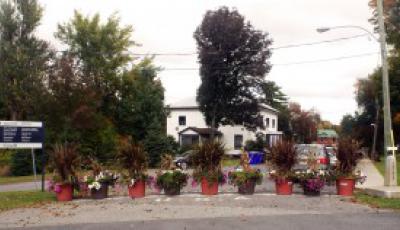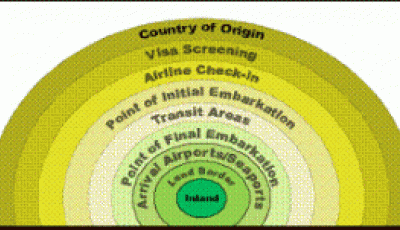The Shifting Landscape of the Canadian Border and the Politics of Refugee Exclusion
Posted:
Time to read:
Post by Efrat Arbel. Efrat holds a doctorate from Harvard Law School and is a postdoctoral fellow at University of British Columbia Faculty of Law. Her research analyzes Canadian approaches to rights protection within and across three fields of law: migration law, Aboriginal law, and prison law. Follow her on Twitter: @earbel.
In an era of fortified border walls and enhanced border controls, not many stories are told about the Canadian border. Commonly referred to as the “world’s longest undefended border,” the 8,891 kilometer land border Canada shares with the United States is not marked by barbed wire fences and militarized walls, but with monuments of peace and friendship, and lush gardens where moose and deer roam free. In at least one border crossing point between Derby Line, Vermont and Stanstead, Québec, a row of flowerpots marks the international boundary line dividing one country from the other.


The altered landscape of the Canadian border has particular significance for asylum seekers. Under the rubric of the Multiple Borders Strategy, Canada has expanded its use of interdiction and interception measures at each of the external borderlines marked in the above diagram: countries of origin, points of departure and arrival, points of transit, and points of initial and final embarkation. These measures impact asylum seekers in detrimental ways, either directly by preventing them from reaching Canada, or indirectly by closing avenues by which they would otherwise travel to Canada.
These measures were the focus of a recent study conducted by the Harvard Immigration and Refugee Law Clinical Program. The study led to the publication of a large-scale report released in November 2013, titled Bordering on Failure: Canada-U.S. Border Policy and the Politics of Refugee Exclusion. The report was co-authored by Alletta Brenner and myself, and overseen by Deborah Anker, Clinical Professor at Harvard Law School and Director of the Harvard Immigration and Refugee Law Clinical Program. It examined a series of measures implemented under the rubric of the Multiple Borders Strategy, and also analyzed the Canada-U.S. Safe Third Country Agreement, a bilateral “refugee sharing” agreement between Canada and the United States in effect since 2004. Through research of Canadian and U.S. law, data collection, and fact-finding investigations conducted along the Canada-U.S. border, we examined the effects of these measures on asylum seekers on both sides of the border.
The image that emerged from this study differed starkly from that of the open, flower-lined border pictured above. Our research showed that through the Multiple Borders Strategy and the Safe Third Country Agreement, Canada is systematically closing its borders to asylum seekers, and circumventing its refugee protection obligations under domestic and international law. While Canada has a valid interest in regulating its borders to ensure refugee protection is reserved only for genuine refugees, our research showed that neither the Multiple Borders Strategy nor the Safe Third Country Agreement serve this interest. Instead, we found that these measures deter, deflect, and block asylum seekers from lawfully making refugee claims in Canada in arbitrary and unprincipled ways, and do not effectively serve the goal of protecting the integrity of the Canada-U.S. border. Our investigations showed that since the Safe Third Country Agreement came into effect in 2004, unauthorized border crossings and Canada-bound human smuggling attempts had increased, making the Canada-U.S. border more dangerous and disorderly, threatening the lives and safety of asylum seekers, and raising serious security concerns.
The findings made in Bordering on Failure also drive towards another alarming conclusion. The more the Canadian border is tightened, and the more human smuggling and unauthorized border crossings continue to increase, the more asylum seekers are at risk of being designated as “illegal” or “irregular” upon arrival. Indeed, recent changes in Canadian law empower the Canadian government to designate two or more people who arrive in Canada together as “designated foreign nationals” or “irregular arrivals” based on a mere suspicion – not proof – that they have been smuggled into Canada. The consequences of being designated “irregular” are significant, and include mandatory detention (for those over fifteen years of age), no right to appeal adverse decisions, and no right to apply for permanent residence or family reunification for five years even after a refugee claim is recognized.
In this key respect, by tightening and re-charting Canada’s borders, the Multiple Borders Strategy measures and the Safe Third Country Agreement not only shift Canada’s boundary line, but also, shape the juridical relationship produced by that boundary, as well as the rights and duties it prescribes. These measures thus do much more than reconstitute Canada’s borders; they also reconstitute the asylum seekers who cross these borders through discourses of irregularity and illegality. These discourses are, in turn, deployed to justify the ongoing fortification of Canada’s borders, to validate the expansion of Canada’s immigration detention powers, and to further diminish the scope of protection available to asylum seekers under Canadian law.
Share:








